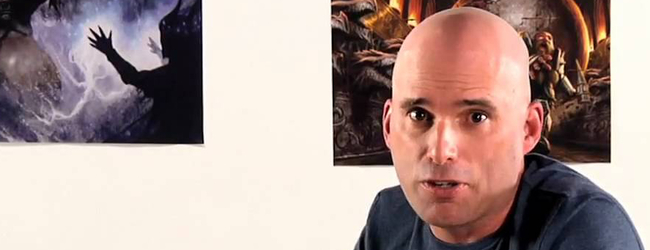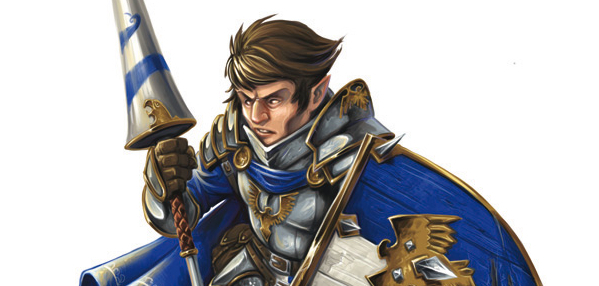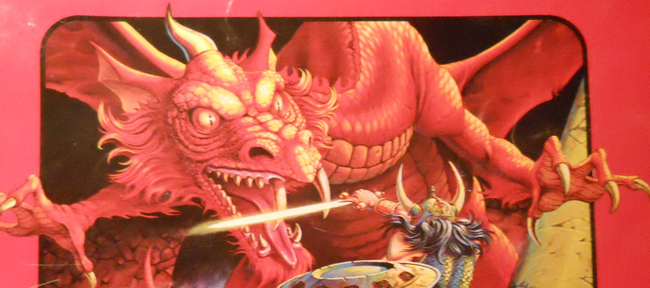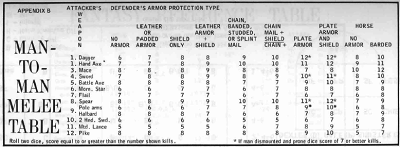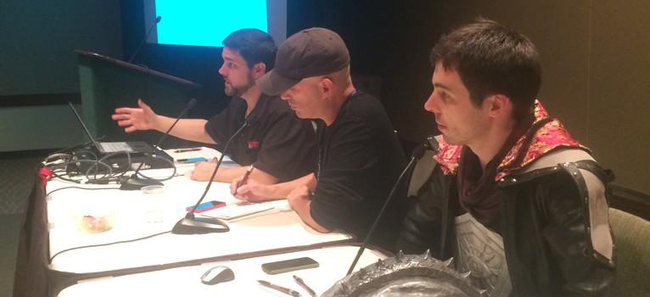Why not fight everything?
I had the opportunity this weekend to briefly speak with three of Dungeons and Dragons’ lead designers: Rodney Thompson, Greg Bilsland, and the most inspiring DM I’ve ever met, Chris Perkins. Their panel, “Art of the Dungeon Master,” an annual panel at PAX Prime was a window into minds of three of the world’s most avid D&D players.
Being a Dungeon Master is not an easy job; on top of the requisite dedication to the game and camaraderie with your players that every DM needs, a truly great game master needs to have a mind for math, a deep understanding of how the game works, an almost preternatural ability to read their players, great improvisational instincts, and the ability to love playing no matter what happens. Being good at making funny voices helps, too. Though I’ve never had the chance to play at Chris Perkins’ table, it’s clear from the live games he’s DMed that he has honed all of these qualities to a needle-fine point. (And he has a shaved head of +2 charisma.)
But this is not a Chris Perkins appreciation post (sorry Chris), so let’s talk about combat. By page count, it’s the biggest part of the D&D game, regardless of edition. Characters gain dozens of new ways to kill their enemies as they advance in level, and they gain these levels typically by killing monsters or, in old-school games, by killing them and taking their gold. The game developers have created myriad rules dedicated to adjudicating combat, but rarely give more than a few suggestions on how to roleplay. An entire third of the Player’s Handbook is dedicated to spells, most of which can be used to kill things in unnecessarily extravagant ways.
Even fifth edition D&D, which boasts roleplaying guidelines that go well beyond any other edition to date, has put the bulk of its pages into detailing the fine art of killing stuff. The front-and-center position of a character’s Traits, Ideals, Flaws, and Bonds on the new character sheet does a lot to emphasize the importance of role playing in the game, and even the Fate-like Inspiration mechanic provides a small in-game incentive to staying in character. As someone who enjoys a balance of roleplay and wholesale goblin slaughter, I love the expanded focus on roleplaying qualities. And yet, the real estate given to these traits is minuscule compared to that given to one’s attacks, spells, and class abilities.
Why am I so hung up on things like page count and the size of certain boxes on the character sheet? It’s not page-count envy. If the benefits of roleplaying can be summed up more concisely than the sprawling lists of combat options, then that’s all the better for us. But there is a clear imbalance in attention. There are hundreds of fascinating, codified combat abilities present in the book and astonishingly few codified roleplaying abilities. There are an abundance of options spelled out in the pages of the Player’s Handbook discussing exactly how your character can fight. Rangers of a certain level can shoot forth a volley of arrows, Wizards of a certain level can hurl a fireball or paralyze a monster, and certain Fighters get a plethora of combat maneuvers that can overwhelm their enemies. These abilities are cool. When a player or a DM reads an ability they like, they’ll say, “Wow, I really want to see that in action,” and remember it when combat arises. Rarely do options like these appear to roleplayers.
Which isn’t to say that there are none. The 5th edition Player’s Handbook is the first D&D book I have ever read that made me want to play as a Gnome (a player race that I’ve always thought steps on the toes of both the stout, cheerful halflings and the pointy-eared, magical elves), and not at all because of their abilities. Each fantasy race in the Player’s Handbook is prefaced by both a literary excerpt from published D&D fiction and by a prose description of each race that makes me want to play like no other Player’s Handbook has. It reinforced in my mind that each character is not just a handful of numbers and attack bonuses, important though those numbers may be, but instead a character with a culture, wants, and needs. Longear Bigtoes the gnome is not just a 6th-level Paladin with +1 lance of demon toad smiting, he is a charming country farmer who loves red cabbage stew, but left his farm and took on the oath of his god to protect his homeland from Mephistopheles’ army of blood-sucking demon toads.
This is the heart of the issue. Combat sticks out. It has a huge page presence, and nearly everything in the D&D game is geared towards making your character better at it. Let me reiterate, though, that while players who are locked in a kill-‘em-all mindset can be a sticky problem, D&D being combat-focused is not a bad thing. Blowing up three demon toads with a single fireball is always an awesome feeling, no matter what playstyle you prefer. I don’t need D&D to turn into Fiasco (there’s a time and a place for each), it just needs to make a concerted effort to highlight ways to roleplay well. The Player’s Handbook should tell players how to be a good team player, and not let roleplaying (especially self-indulgent roleplaying) get in the way of your friends’ fun.
But why does combat stick out so much more than roleplaying? In 5th edition, lead designer Mike Mearls clearly states that there are three pillars of D&D: Combat, Exploration, and Interaction (roleplaying). Combat gets tons of mechanics, exploration slightly less (though the Ranger class seems to trade effectiveness in battle for unmatched exploration abilities), and interaction almost none. Mearls has stressed that the game is designed to support “rulings, not rules,” which allows the Dungeon Master free reign to interpret rules as they choose and make their own decisions at the table. In the Player’s Handbook, combat is given many specific rules, but the effectiveness of roleplaying solutions is entirely at the discretion of the DM. Why?
It’s because you’re playing Dungeons and Dragons.
Take a step backwards in time. In the early 1970s, D&D’s two original creators, Gary Gygax and Dave Arneson, married the ideas of two distinct games. Gygax, a designer of medieval wargames, recently co-authored a game called Chainmail, designed to simulate large-scale medieval warfare. And Arneson had the honor of playing in Braunstein, the first ever roleplaying game, in the modern “tabletop” sense. When Chainmail and Braunstein met, whose influence was greater over the final product that was classic D&D?
Chainmail by a mile. The first several iterations of Dungeons and Dragons were so choked with tables and charts and mechanics for operating combat and stealth and wilderness travel, that it became easy to miss the point of the game. The mechanics of D&D were so overwhelmingly combat-focused, that it was easy to miss that there was a non-combat part of the game at all. Arneson “won” Braunstein (unlike D&D, Braunstein had distinct win conditions) entirely through guile and roleplaying. You’d be hard-pressed to overcome every challenge in a Dungeons and Dragons campaign without ever entering combat. The game isn’t designed to accommodate that. Even Arneson, who created a fantasy campaign of his own after meeting Gygax, made adventures in the fantasy realm of Blackmoor more like Chainmail than like Braunstein. At the inception of the hobby, fantasy was the realm of wargaming, not of storytelling.
D&D’s wargaming legacy manifests in dozens of ways, but it is most clear in the rulebooks, even in 5th edition. D&D is a rules-heavy game, and most of its rules are dedicated to determining how well you fight monsters. I started playing in the game’s 3rd edition, and there were dozens of supplemental books full of feats and abilities that dictated exactly how much better and fighting things or casting spells you would become if you learned them. 4th edition caught a lot of flak for taking this one step further and focusing the bulk of the rules on unique powers and abilities that the different classes could use in combat, while leaving interaction and roleplaying almost entirely subject to DM arbitration. But the truth is, whether you’re playing AD&D, 5th edition, or anything in between, nothing in the rules will tell you about “winning” through roleplay.
And if someone doesn’t know they can triumph through roleplay, odds are they won’t try to. In fact, when your class name is Fighter and your job description is best at fighting, negotiating probably isn’t the first thing on your mind. Again, I refer to combat sticking out, even in class names.
So why not fight everything?
The obvious answer is that the NPCs won’t like you. But you can just kill them, too, so that point’s moot. (The even more obvious answer is that the DM won’t like you, and you probably shouldn’t kill her.) Last weekend, at PAX, I had the opportunity to ask three of the great DMs and designers of our time why murder might not always be the best option. And the answer was almost unanimous: it’ll make things much harder for you if a sharp sword is your only tool. You aren’t the only hammer in this world of nails.
Rodney Thompson, lead rules designer on D&D’s 5th edition fielded my question first.
“If it is a way to accomplish all your goals to just kill everyone… If you can do it, you will. I tend to put situations where just murdering the guy is not the best solution. Think about their objectives and goals.”
The DM does have to be wary about making combat always a solution. If a DM wants her players to think outside the box, it’s her prerogative to think out of the box herself. Focusing on the objectives and goals of the players’ characters is a good way to think of interesting ways to present unique social encounters. But if the character’s goal is simply to kill everything, then maybe consider the player’s objectives. If all the player wants to do is hack ‘n slash their way through a game that is not designed to be won purely through combat, then you might have a fundamental mismatch in play styles. The player and the DM need to have a chat, because neither of them will come out of this game happy if they continue to grate against each other. If they can’t make that change—that is, there’s an irreconcilable difference in play styles at your table—then it’s time to search for another gaming group, as sad as that might be. Roll20 is a great resource for online games, and many forums, like Giant in the Playground have play-by-post boards.
Greg Bilsland, the game’s producer, and DM of the latest D&D livestream adventure, answered next, and spoke again to the ideas of player mismatch.
“Just knowing the type of players you have…if you have players you have fun playing with, the DM will have fun as well. Try to match yourself to the player, if you have the opportunity to choose your players.”
What he says is true; not every DM has the luxury of being able to choose their players. At the Wizards of the Coast office especially, DMs there have their pick of some of the most eager and varied D&D players anywhere. People who live in remote places or in cities that don’t have a large population of tabletop RPG players really have to take what they can get, even in the age of internet gaming.
But Chris Perkins spoke to groups of players who may not be aware that you can overcome obstacles in D&D through guile and wit, like Dave Arneson did.
“In my games there are always underlying politics. In my games, my villains are always very politically connected, but to people…who aren’t necessarily so, and if the players kill [the villain] they essentially weaken their position in the eyes of their allies…[There’s a] bad guy who’s the son of the baron who’s just gone completely off the deep end and doing all kinds of evil stuff, but the baron is a nice guy.”
“Simply slaughtering his son isn’t going to endear you to the baron, and that could cause political repercussions which could actually make the adventure and the campaign a lot harder. And if they realize that that’s true, that that sort of realistic consequence to their vicious actions, then they might be a little bit more trepidatious about just running the guy through.”
There it is. This advice applies best to groups with new players, but it also applies very well to groups of gamers who like both roleplay and combat, and to groups with a wide variety of player types. Here’s the final word. If you, as a DM, don’t like your players murdering their way through your campaign, give them reason not to. If you, as a player, don’t like your campaign because the only way to win is to murder your way through it, consider talking to your DM and your fellow players. Everyone at the gaming table should be having fun, and if they aren’t, a change needs to be made.
(Gnome paladin artwork credit to http://fstitz.deviantart.com/).
